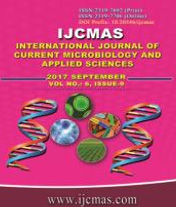


 National Academy of Agricultural Sciences (NAAS)
National Academy of Agricultural Sciences (NAAS)

|
PRINT ISSN : 2319-7692
Online ISSN : 2319-7706 Issues : 12 per year Publisher : Excellent Publishers Email : editorijcmas@gmail.com / submit@ijcmas.com Editor-in-chief: Dr.M.Prakash Index Copernicus ICV 2018: 95.39 NAAS RATING 2020: 5.38 |
A field experiment was conducted at ICAR-Indian Institute of Horticultural Research, Bengaluru to assess the interaction effects of combined application of Magnesium (Mg) and Potassium (K) on soil properties and yield of tomato. Results showed that mean effect of applied Mg resulted in 23 per cent to 28 per cent higher yield up to a doze of 50 kg Mg ha-1 as compared to non-application of magnesium. The application of K also significantly influenced the yield. The dose of 100 kg K ha-1 along with 50 kg Mg ha-1 recorded the highest yield of 84.39 kg ha-1 which was 13 per cent higher compared to non-application of K. Graded levels of Mg and K did not have any significant effect on either soil pH, EC and OC. Application of Mg and K did not have any significant influence on soil available N. With an increase in the applied Mg levels, the mean available N content decreased. The results showed that with the increase in the applied Mg levels the mean available P content decreased upto 5 per cent. Similarly, the application of Mg and K together significantly had negative influence on soil available K and Ca. The mean available K content decreased with the increase of Mg level. These results indicated the existence of antagonism among Mg, K and Ca in the soil. Hence, when the soil is deficient in K and Mg, the deficiency of Mg should be corrected before applying K fertilizer for achieving higher yields.
 |
 |
 |
 |
 |